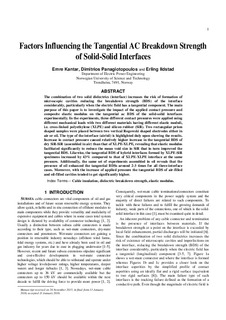Factors influencing the tangential AC breakdown strength of solid-solid interfaces
Journal article, Peer reviewed
Permanent lenke
http://hdl.handle.net/11250/2401152Utgivelsesdato
2016Metadata
Vis full innførselSamlinger
- Institutt for elkraftteknikk [2412]
- Publikasjoner fra CRIStin - NTNU [37219]
Originalversjon
IEEE transactions on dielectrics and electrical insulation 2016, 23(3):1778-1788 10.1109/TDEI.2016.005744Sammendrag
The combination of two solid dielectrics (interface) increases the risk of formation of
microscopic cavities reducing the breakdown strength (BDS) of the interface
considerably, particularly when the electric field has a tangential component. The main
purpose of this paper is to investigate the impact of the applied contact pressure and
composite elastic modulus on the tangential ac BDS of the solid-solid interfaces
experimentally. In the experiments, three different contact pressures were applied using
different mechanical loads with two different materials having different elastic moduli,
i.e. cross-linked polyethylene (XLPE) and silicon rubber (SiR). Two rectangular prism
shaped samples were placed between two vertical Rogowski shaped electrodes either in
air or oil. The type of the interface (air/oil) is highlighted duly upon showing the results.
Increase in contact pressure caused relatively higher increase in the tangential BDS of
dry SiR-SiR (assembled in air) than that of XLPE-XLPE, revealing that elastic modulus
facilitated significantly to reduce the mean void size in SiR that in turn improved the
tangential BDS. Likewise, the tangential BDS of hybrid interfaces formed by XLPE-SiR
specimens increased by 43% compared to that of XLPE-XLPE interface at the same
pressure. Additionally, the same set of experiments assembled in oil reveals that the
presence of oil enhanced the tangential BDSs around 2-3 times for all three-interface
cases. Moreover, with the increase of applied pressure the tangential BDS of air-filled
and oil-filled cavities tended to get significantly higher.
